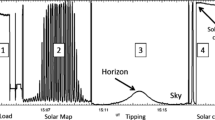Abstract
Peak flux spectra of solar radio bursts in a wide frequency band have been statistically determined for different morphological types of bursts, for various ranges of magnetic field of the burst-associated sunspots and also for the bursts occurring in the central and limb region of the solar disk. Important results obtained are: (i) The generalised spectra have two peaks, one near to meter-wave and the other in the centimeter-wave region, the former peak being more pronounced than the latter; (ii) identical spectral shape is observed for the great and impulsive types and also for GRF and PBI types of bursts; (iii) the radio emission intensity is relatively higher in the central part than that in the limb part of the solar disk for frequencies 1–10 GHz, while the reverse is true for frequencies 0.245–1 GHz and 10–35 GHz; (iv) the optical depth of the absorbing layer above the source of a burst is found to be the same for meter to centimeter-wavelength bursts, implying that the radio sources in this wide band have uniform characteristics with respect to optical thickness; (v) in case of simultaneous emission in the dekameter to X-ray band, most of the decimetric bursts are seen to be very prompt and coincident with the associated flare's starting time. The interpretations of the obtained spectra give an insight into the possible generation mechanisms, pointing to the location of the source region in the solar atmosphere.
Similar content being viewed by others
References
Akabane, K.: 1956, Publ. Astron. Soc. Japan 8, 173.
Castelli, J. P., Aaarons, J., Michael, G. A., Jones, C., and Ko, H. C.: 1969, Solar Flares and Space Research, North-Holland Publ. Co., Amsterdam.
Croom, D. L.: 1971, Nature 229, 142.
Das Gupta, M. K. and Sarkar, S. K.: 1971, J. Roy. Astron. Soc. Canada 65, 152.
Fokker, A. D.: 1969, Solar Phys. 8, 376.
Hachenberg, O. and Wallis, G.: 1961, Z. Astrophys. 52, 42.
Holt, S. S. and Ramaty, R.: 1969, Solar Phys. 8, 119.
Kakinuma, T., Yamashita, T., and Enome, S.: 1969, Proc. Res. Inst. Atmospherics, Nagoya Univ. 16, 127.
Kawabata, K.: 1960, Rep. Ionosphere Space Res. Japan 14, 405.
Kawabata, K.: 1966, Rep. Ionosphere Space Res. Japan. 20, 118.
Kundu, M. R.: 1965, Solar Radio Astronomy, Inter Science Publishers, New York.
Kundu, M. R.: 1963, Space Sci. Rev. 2, 438.
Piddington, J. H.: 1951, Monthly Notices Roy. Astron. Soc. 111, 45.
Ramaty, R.: 1969, Astrophys. J. 158, 753.
Ramaty, R. and Petrosian, V.: 1972, Astrophys. J. 178, 241.
Ramaty, R.: 1973, in R. Ramaty and P. G. Stone (eds.), High Energy Phenomena on the Sun, NASA SP-342, p. 188.
Smerd, S. F.: 1964, Ann. IGY 34, 331.
Takakura, T.: 1967, Solar Phys. 1, 304.
Takakura, T.: 1972, Solar Phys. 26, 151.
Author information
Authors and Affiliations
Rights and permissions
About this article
Cite this article
Das Gupta, M.K., Das, T.K. & Sarkar, S.K. Wide-band average spectra of solar radio bursts. Sol Phys 67, 109–120 (1980). https://doi.org/10.1007/BF00146687
Revised:
Issue Date:
DOI: https://doi.org/10.1007/BF00146687



